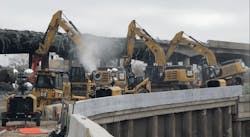Mile High Shift makes way for next step of Central 70 Project in Colorado
As part of the Colorado Department of Transportation’s (CDOT) Central 70 Project, the much-anticipated Mile High Shift took place yesterday morning as I-70 reopened between I-270 and Washington Street.
CDOT says crews worked around the clock over the weekend to prepare for traffic to enter the new lowered section of I-70 between Colorado and Brighton boulevards for the first time. All six lanes of I-70 traffic were moved from the existing viaduct onto the future westbound lanes of I-70, making way for demolition of the 57-year-old viaduct and the build-out of the future eastbound lanes of I-70 and 46th South Avenue.
Now that traffic is in the new lowered section, the department says it is time to finish demolishing the old I-70 viaduct and build out the eastbound lanes. On Saturday, May 22, crews began demolishing I-70 just east of Brighton and just west of Colorado boulevards. For the past 57 years, this viaduct has stood as a connector for eastbound and westbound traffic along I-70; however, it was no longer able to accommodate the nearly 200,000 motorists who travel this stretch of roadway today nor the projected growth in the years to come.
“The viaduct demolition represents Denver’s incredible growth over the past six decades,” CDOT Project Director Bob Hays said in a statement. “This demolition is a major transportation milestone, but also a moment to pause and reflect on how the Denver metro area has evolved since the 1960s. We’re excited to start this next phase and continue to help contribute to the state’s future.”
Once demolished, crews can begin building the new eastbound lanes of I-70 in the lowered section (between Brighton and Colorado boulevards). The viaduct will be demolished in sections primarily during daytime hours using excavators, crushers and concrete grinders. The demolition is anticipated to take approximately five months.
Central 70’s developer, Kiewit Meridiam Partners, has committed to going above and beyond by installing various vibration monitors between Brighton and Colorado boulevards to ensure demolition activities do not go beyond baseline vibration thresholds.
------------
SOURCE: Colorado DOT
